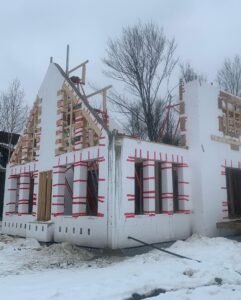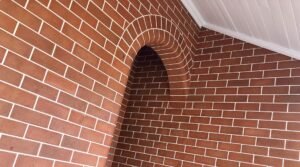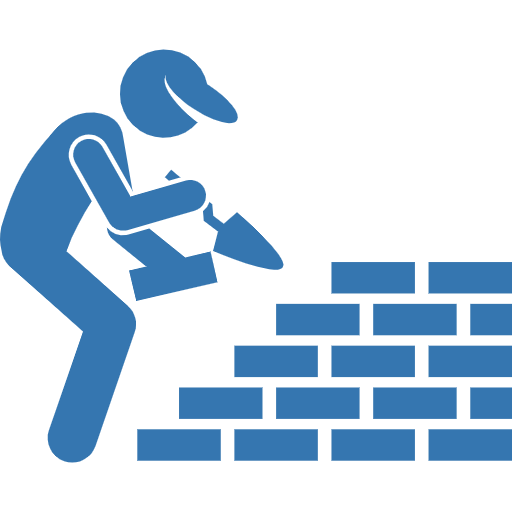Retaining walls are engineering feats designed to hold back soil and transform sloped landscapes into functional spaces. However, their true strength lies not in the materials you see (like stone or concrete) but in the hidden drainage systems that combat water’s destructive force. But without proper drainage, even the sturdiest wall can crumble under the silent force of water. At TheFixItGuys, licensed with 15+ years of expertise, we’ve seen how poor drainage leads to 70% of retaining wall failures.
In this guide, you’ll learn why retaining wall drainage systems like weep holes, gravel backfill, and perforated pipes are non-negotiable and how our science-backed approach keeps Toronto properties safe.
1. Hydrostatic Pressure: The Invisible Threat to Retaining Walls
Water pooling behind a retaining wall exerts hydrostatic pressure—a sideways force that can crack concrete, warp timber, and topple stone.
The Science:
- Hydrostatic pressure increases by 62.4 pounds per square foot (psf) for every foot of water depth.
- A 4-foot wall with poor drainage can face over 250 psf of pressure—equivalent to the weight of a compact car.
Why Toronto’s Climate Exacerbates the Risk
Toronto’s freeze-thaw cycles and heavy rainfall (avg. 831 mm/year) make drainage critical:
- Winter: Water trapped behind walls freezes, expanding and cracking materials.
- Spring Thaw: Melting snow saturates soil, spiking hydrostatic pressure.
Case Study: A Costly Lesson in Vaughan
A homeowner built a 6-foot concrete wall without drainage. After a record rainfall, hydrostatic pressure cracked the base, requiring a $20,000 rebuild. Our engineers later discovered:
- Clay backfill trapped water like a sponge.
- Zero weep holes or pipes to relieve pressure.
Lesson: Even “sturdy” materials fail without drainage.
2. 3 Essential Drainage Systems (and How They Work Together)
A. Weep Holes: Your Wall’s Pressure Release Valves
Weep holes are small openings (typically 3–4 inches in diameter) drilled at the wall’s base to allow water to escape.
Best Practices for Effective Weep Holes:
- Spacing: 1 hole every 4–6 linear feet.
- Installation: Angle downward (5–10°) to encourage drainage.
- Protection: Use PVC sleeves or stainless steel grates to prevent clogging.
Common Mistake:
Placing weep holes too high (water pools below them). Always position at the lowest point of the wall.
B. Gravel Backfill: The Unsung Hero of Drainage
A 12-inch layer of washed gravel (¾-inch aggregate) behind the wall serves two purposes:
- Reduces Pressure: Gravel’s permeability cuts soil-to-wall pressure by 30–40%.
- Filters Sediment: Prevents soil from clogging weep holes and pipes.
Pro Tip: Pair gravel with geotextile fabric—a filter layer that blocks fine soil particles while allowing water to pass.
C. Perforated Pipes: The Underground Lifeline
Perforated drainage pipes (4–6 inches in diameter) are buried at the wall’s base to collect and redirect groundwater.
Installation Checklist:
- Slope: Lay pipes at a 1–2% gradient (1/4 inch per foot) toward a storm drain or daylight.
- Protection: Wrap pipes in geotextile fabric to prevent soil intrusion.
- Maintenance: Inspect annually for clogs (e.g., root growth).
Why All Three Systems Matter:
Weep holes handle surface water, gravel manages subsurface flow, and pipes channel bulk groundwater away. Missing one compromises the entire system.
3. Case Study: Rescuing a Leaning Wall in Mississauga
Background:
A homeowner installed a 5-foot natural stone wall with clay backfill. Within two years, the wall leaned 8 inches due to waterlogged soil.
Our Diagnosis:
- Trapped Water: Clay backfill acted like a dam, preventing drainage.
- No Pressure Relief: Zero weep holes or pipes.
Solution:
- Weep Holes: Drilled 6 holes (4-inch diameter) with stainless steel grates.
- Gravel Backfill: Excavated clay and replaced it with 12 inches of washed gravel.
- Perforated Pipe: Installed a 4-inch pipe wrapped in geotextile, sloped toward a storm drain.
Result:
- Immediate stabilization (0.5 inches of rebound within a week).
- No movement observed after three years, despite record rainfall.
Explore more projects in our retaining wall portfolio.
Top 5 DIY Drainage Mistakes (and How to Avoid Them)
-
Using Clay or Topsoil Backfill
- Risk: Retains water, increasing hydrostatic pressure.
- Fix: Always use washed gravel or crushed stone.
-
Skipping Geotextile Fabric
- Risk: Soil migrates into gravel, clogging weep holes/pipes.
- Fix: Install fabric between soil and gravel layers.
-
Improper Weep Hole Placement
- Risk: Holes too high or sparse leave water trapped.
- Fix: Follow the 4–6-foot spacing rule at the base.
-
Ignoring Local Building Codes
- Risk: Toronto requires drainage for walls >3 feet. Non-compliance = fines + liability.
- Fix: Consult Ontario Building Code (OBC) Section 4.2 or hire a pro.
-
Forgetting Maintenance
- Risk: Clogged weep holes or pipes render systems useless.
- Fix: Inspect drainage systems annually, especially after storms.
5. Why Professional Engineering is Non-Negotiable
A. The Science Behind Our Designs
Our engineers use advanced tools to outsmart hydrostatic pressure:
- Hydrostatic Pressure Calculations: Tailored to Toronto’s soil types (e.g., clay in Scarborough, loam in Etobicoke).
- 3D Drainage Modeling: Software like Plaxis simulates water flow to optimize weep hole/pipe placement.
- Load Analysis: Ensures walls can handle soil weight + surcharge loads (e.g., patios, pools).
B. Compliance with Strict Standards
- ASCE 7-16: Guidelines for lateral soil pressure and seismic loads.
- Ontario Building Code (OBC): Section 4.2 mandates drainage for walls >1 meter (3.28 feet).
C. Long-Term Cost Savings
- DIY Drainage: Initial cost: ~15–15–25/sq.ft. (high failure risk).
- Professional Design: ~30–30–50/sq.ft. (includes warranties and 25+ year lifespan).
6. Beyond Drainage: 3 Extra Tips for Retaining Wall Longevity
- Soil Compaction: Poorly compacted backfill settles, creating voids where water pools. Use a plate compactor every 6 inches of backfill.
- Capillary Breaks: Install a 2-inch layer of crushed stone beneath the wall to block groundwater wicking.
- Vegetation Control: Plant roots (e.g., willow trees) can crack walls. Keep plants 10+ feet away.
Conclusion
Retaining wall drainage isn’t a luxury—it’s a lifeline. From hydrostatic pressure calculations to perforated pipe slopes, every detail ensures your wall withstands Toronto’s climate extremes.
Don’t gamble with DIY drainage:
👉 Schedule a professional drainage assessment or call us at (647) 363-5205.















